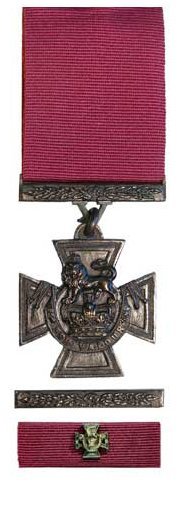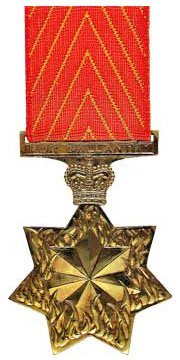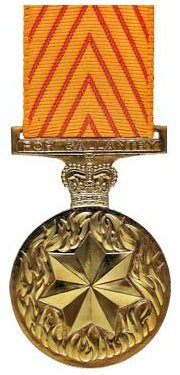
AUSTRALIAN BRAVERY ASSOCIATION
Decoration & Awards
Australian Gallantry Decorations
A range of awards to recognise gallantry was introduced to the Australian system to replace Imperial awards in 1991. The only award retained from the Imperial system is the Victoria Cross, which was renamed Victoria Cross for Australia.
The key differences between the Australian awards and those of the Imperial system are that the awards are applied to all the Services and that the level of the award is not restricted by rank but is determined by the quality of the action or service.
A further difference is the establishment of unit awards for gallantry, which were not previously available under the Imperial system.
Victoria Cross for Australia
All ranks of the Services may be nominated for this award. The VC was awarded to Australians under the Imperial system of awards, with 96 Australians receiving the award. It was decided to retain the VC as the pre-eminent gallantry award in the Australian system.
The VC is awarded for the most conspicuous gallantry, or a daring or pre-eminent act of valour or self-sacrifice, or extreme devotion to duty in the face of the enemy. The Victoria Cross for Australia was approved on 15 January 1991.
Corporal Mark Gregor Strang Donaldson, VC was awarded the first Victoria Cross for Australia for most conspicuous acts of gallantry in action in a circumstance of great peril in Afghanistan as part of the Special Operations Task Group during Operation SLIPPER, Oruzgan Province, Afghanistan on 2 September 2008. Click here to view his citation and other relevant information.
A second Victoria Cross for Australia was awarded to Corporal BenjaminRoberts-Smith VC MG for the most conspicuous gallantry in action in circumstances of extreme peril as Patrol Second-in-Command, Special Operations Task Group on Operation SLIPPER on 11 June 2010. Click here to view his citation and other relevant information.
Corporal Daniel Alan Keighran VC was awarded the third Victoria Cross for Australia For the most conspicuous acts of gallantry and extreme devotion to duty in action in circumstances of great peril at Derapet, Uruzgan Province, Afghanistan as part of the Mentoring Task Force One on Operation SLIPPER on 24 August 2010. Click here to view his citation and other relevant information.
Insignia: The Victoria Cross for Australia is identical to the original VC. It is a bronze cross with the obverse having a Crowned Lion standing on the Royal Crown with the words “FOR VALOUR” inscribed on a semicircular scroll below the Crown. The reverse has the date of the act for which the Cross is awarded engraved within a circle in the centre. The Cross is suspended by a ring from a seriffed “V” attached to a suspension bar decorated with laurel leaves.
Ribbon: The VC ribbon is crimson and 38 mm wide. When the ribbon is worn alone a ribbon bar emblem in the form of a replica of the Cross is worn on the ribbon.
Postnominal: Recipients of the Victoria Cross are entitled to the postnominal letters ‘VC’. Recipients of a bar to the VC add ‘and Bar’ to the postnominal.
The VC is worn ahead of all other awards.
Star of Gallantry
The Star of Gallantry (SG) was introduced in 1991 and is awarded for acts of great heroism or conspicuous gallantry in action in circumstances of great peril.
Insignia: The SG is a gold-plated Federation Star, with the obverse having a central device of a smaller Federation Star in a field of flames. The reverse has a central panel for recipient details on a stepped background. The suspension bar is inscribed on both obverse and reverse with “FOR GALLANTRY”.
Ribbon: The SG ribbon has a design of chevrons of deep orange alternating with chevrons of light orange. The ribbon is worn with the points facing upwards.
Postnominal: Recipients of the Star of Gallantry are entitled to the postnominal letters ‘SG’.
Recipients of a bar to the SG add ‘and Bar’ to the post-nominal.
Medal for Gallantry
The Medal for Gallantry (MG) was introduced in 1991 and is awarded for acts of gallantry in action in hazardous circumstances.
Medal: The MG is a gold-plated medal with the obverse having a central device of a Federation Star on a circle of flames representing action under fire. The reverse has a panel for recipient detail over a design of fluted rays of varying lengths. The suspension bar is inscribed on both obverse and reverse with “FOR GALLANTRY”.
Ribbon: The MG ribbon has a design of chevrons of light orange alternating with chevrons of deep orange. The ribbon is worn with the points facing upwards.
Postnominal: Recipients of the Medal for Gallantry are entitled to the postnominal letters ‘MG’. Recipients of a bar to the MG add ‘and Bar’ to the postnominal.
Commendation for Gallantry
The Commendation for Gallantry was introduced in 1991 and awarded for acts of gallantry in action which are considered worthy of recognition.
Insignia: The insignia of the Commendation for Gallantry is gold-plated with a Federation Star superimposed centrally on a row of flames.
Ribbon: The Commendation for Gallantry insignia is mounted on a plain orange ribbon. A miniature insignia is worn on the ribbon bar.
Further Awards: Further awards of the Commendation for Gallantry are made by Warrant describing the separate action being recognise. No additional insignia is received or worn.
Postnominal: There is no entitlement to postnominal letters for recipients.
Unit Citation for Gallantry & Meritorious Unit Citation
The Unit Citation for Gallantry is awarded to a unit for extraordinary gallantry in action. The Meritorious Unit Citation is awarded to a unit for sustained outstanding service in warlike operations.
The actual citation is a warrant presented to the unit. Insignia are worn by individuals to denote their membership of a unit that has been awarded a citation. Personnel cannot be issued with the insignia until the authorised unit representative, normally the CO, has been formally invested with the citation.
The insignia of a Unit Citation for Gallantry is a gilt rectangular frame surrounding a deep green ribbon. The frame has a design of flames emanating from the outer edges of the frame to the centre.
The insignia of a Meritorious Unit Citation is a rhodium-plated rectangular frame of the same dimensions and design surrounding a ribbon of old-gold.
Personnel who were members of the unit when an award was made wear a Federation Star in the centre of the ribbon and continue to wear the insignia after leaving the unit. Personnel who are subsequently posted to the unit wear the insignia without the Federation Star and only while actually posted to the unit.






